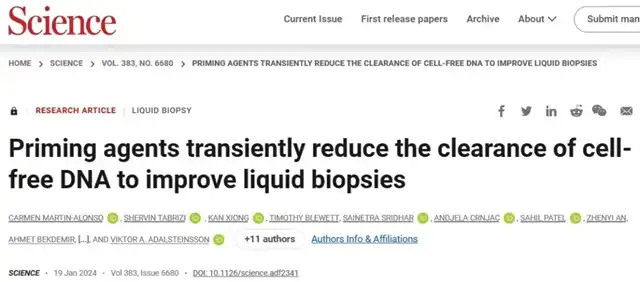Breakthrough in Cancer Liquid Biopsy: Harvard Team Invents ctDNA “Stabilizer”
- Normal Liver Cells Found to Promote Cancer Metastasis to the Liver
- Nearly 80% Complete Remission: Breakthrough in ADC Anti-Tumor Treatment
- Vaccination Against Common Diseases May Prevent Dementia!
- New Alzheimer’s Disease (AD) Diagnosis and Staging Criteria
- Breakthrough in Alzheimer’s Disease: New Nasal Spray Halts Cognitive Decline by Targeting Toxic Protein
- Can the Tap Water at the Paris Olympics be Drunk Directly?
Breakthrough in Cancer Liquid Biopsy: Harvard Team Invents ctDNA “Stabilizer”
- Should China be held legally responsible for the US’s $18 trillion COVID losses?
- CT Radiation Exposure Linked to Blood Cancer in Children and Adolescents
- FDA has mandated a top-level black box warning for all marketed CAR-T therapies
- Can people with high blood pressure eat peanuts?
- What is the difference between dopamine and dobutamine?
- How long can the patient live after heart stent surgery?
Breakthrough in Cancer Liquid Biopsy: Harvard Team Invents ctDNA “Stabilizer”, Boosting ctDNA Collection Rate Tenfold, and Increasing Sensitivity for Small Tumor Detection from 10% to 75%.
The dream of a “blood test for cancer” has been pursued for a long time.
In theory, circulating free DNA (cfDNA) in the blood contains circulating tumor DNA (ctDNA) from tumors, making it a promising material for cancer screening.
However, in reality, the low content and rapid degradation of cfDNA make it challenging to meet testing requirements.
The half-life of cfDNA is only 30-120 minutes. From 10ml of standard blood draw, approximately 5ml of plasma can be separated, providing an average of 10ng of cfDNA per milliliter, equivalent to about 15,000 single-copy genome equivalents (GE).
For advanced cancer patients, the proportion of ctDNA in cfDNA can be as high as 10%. Still, in localized patients, this ratio drops abruptly to 0.1-1%. As for early-stage cancer patients or those undergoing treatment, the proportion of ctDNA may be less than 0.1%.
Clearly, patients with low levels of ctDNA are the ones who would benefit the most from liquid biopsy screening. However, the blood samples from these patients often lack sufficient ctDNA for effective testing. Research data shows that for stage 1 cancer, the sensitivity of screening tests based on ctDNA is only 20-40%.
Is there a way to make trace amounts of ctDNA “visible”?
Last week, the journal “Science” published a new achievement from a scientific team at MIT and the Broad Institute. The researchers tackled the degradation of ctDNA and developed a dual-component pre-treatment agent. By combining lipid nanoparticles and monoclonal antibodies with cfDNA, they reduced cfDNA ingestion by macrophages and degradation by nucleases.
In experiments, injecting the pre-treatment agent 1-2 hours in advance could increase the collected ctDNA by more than 10 times. Subsequent tumor analysis using ctDNA could raise the sensitivity of detecting small tumors from less than 10% to over 75%.
Researchers likened this pre-treatment agent to a contrast agent in the biopsy field, hoping it significantly improves the clinical utility of liquid biopsies.


To increase the extracted sample volume, scientists have come up with various methods. Plasma exchange, for example, requires specialized equipment, is time-consuming, and is not suitable for critically ill patients. Another approach involves sampling closer to the tumor, such as collecting cfDNA in the urine of bladder cancer patients. Interventional methods, like focused ultrasound or radiotherapy, could increase ctDNA shedding.
Ignoring economic issues, the feasibility of the latter two methods relies on knowing the tumor’s location, which is clearly not applicable to cancer screening.
Researchers reconsidered the birth and disappearance of cfDNA and ctDNA, finding the latter to be more promising. The degradation and clearance of ctDNA mainly depend on nuclease degradation, renal excretion, and the mononuclear phagocyte system (MPS). If the disappearance of ctDNA can be delayed, collection becomes much easier.
Researchers devised two methods.
Firstly, cfDNA in circulation binds with histones, forming nanoparticles with a diameter of approximately 11nm. The researchers designed a similar lipid nanoparticle that can compete with cfDNA for ingestion by MPS, reducing cfDNA clearance. Secondly, using monoclonal antibodies to bind with cfDNA can prevent it from nuclease degradation.
Experiments in mice confirmed the effectiveness of both methods. Using either method alone significantly increased the amount of cfDNA samples collected 1 hour after injection.
In MC26 lung metastasis mice, the pre-treatment agent injection also significantly increased plasma cfDNA content. In the 1st/2nd/3rd week of tumor progression, the concentrations of collected cfDNA were 7/14/28 times those of the control. Analyzing 1822 tumor-specific single nucleotide variations (SNV) in the samples, the numbers of mutations identified at three time points were 4/19/60 times higher.
Setting 2 SNV as the threshold, low-tumor-burden mice struggled to detect tumors. However, with the lipid nanoparticle pre-treatment agent, 75% of mice were detected.
Similarly, with the monoclonal antibody pre-treatment agent, using 0.33ml of blood sample, detection of low-tumor-burden or minimal residual disease level ctDNA (approximately 1-10/million) was achieved, much lower than conventional blood draws.
Moreover, the impact of the pre-treatment agent on cfDNA is not long-lasting; normal levels could be restored within 24 hours. This suggests that the usage scenario for patients is indeed similar to contrast agents, injected 1-2 hours before blood tests and quickly metabolized by the body.
Of course, the application effectiveness and tolerance of this pre-treatment agent in the human body still need further research confirmation.
Breakthrough in Cancer Liquid Biopsy: Harvard Team Invents ctDNA “Stabilizer”
(source:internet, reference only)
Disclaimer of medicaltrend.org
Important Note: The information provided is for informational purposes only and should not be considered as medical advice.



